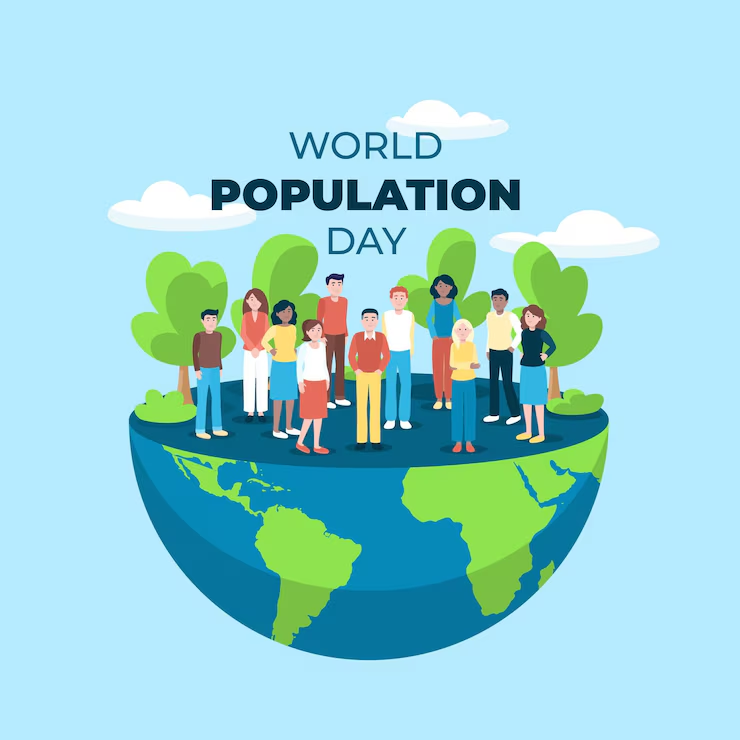July 11 marks World Population Day, a moment to reflect not just on numbers but on what they mean for policy, development, and national strategy. With over 1.41 billion people, India is now the world’s most populous country, surpassing our northern neighbour China. This year’s theme, “Empowering Young People to Create the Families They Want in a Fair and Hopeful World” reminds nations that every individual matters in planning and policy.
Why is it urgent to talk about India’s population today? And how is the country managing such a vast population?
World Population Day is much more than a date on the calendar. It’s a chance to confront some of the most important issues such as declining fertility rates, food security, healthcare access, education quality, and gender inequality; and how India is dealing with them. Firstly, fertility rates reflect how quickly a population is growing and can signal future workforce trends. India’s fertility rate has declined to 2.0 below the replacement level. Secondly, the Public Distribution System (PDS) also plays a crucial role; a strong PDS ensures food security and cushions the poor against inflation and economic shocks. In India, over 800 million people are covered under national food security schemes and are availing benefits. Thirdly, digital health missions, as these can make healthcare accessible, affordable, and efficient for a vast population. The Ayushman Bharat Digital Mission aims to develop the backbone necessary to support the integrated health infrastructure. Fourthly education; education access and quality are critical to transforming a young population into a productive workforce. Over 98% of children aged 6–14 are enrolled in school, with increasing foundational literacy—thanks to programmes under National Education Policy (NEP) 2020 and Samagra Shiksha. Lastly, gender equity, it reflects how effectively a country mobilizes half its population for economic growth. According to the World Bank Gender Data Portal, the female labour participation in India is currently only 32.8%, compared to a global average of about 50%. Furthermore, only 23.1% of women aged 15 and above have an account at a financial institution compared to 35.4% of men. Mean years of schooling for females are 4.8 years and for males 8.2. Women are underrepresented in higher positions/managerial posts and earn lesser incomes for performing similar work.
A growing population has two major issues, youth unemployment and ageing. Unemployment has been a significant issue hindering the nation’s growth because we have a large working population but don’t have enough job opportunities, due to which unemployment has been rising and will result in national loss. Youth unemployment is rising above 23% in urban areas. The second stumbling block is the ageing woe; on the one hand, India’s fertility is declining, on the other, the life expectancy has increased from 49.7 years in 1970s to 70 years in 2022. As a result, India has more elders than children. Without active plans such as pension schemes, eldercare systems, and healthcare improvement, the current situation may soon transition into fiscal liability. Ageing is on the horizon, especially in states like Kerala and Tamil Nadu.
What must India do?
Instead of focusing on population control, policymakers can focus on enhancing opportunities and capabilities, such as:
- Skill youth across all states in urban as well as rural areas. For example, the PM Kaushal Vikas Yojana (PMKVY) and the Mukhya Mantri Kaushal Samvardhan Yojana (in Madhya Pradesh). With the successful implementation of such programmes, India can create a more competent and job-ready workforce across regions.
- Encourage the female labour force. For instance, Mission Shakti (in Odisha), Mahila E-Haat, and Stand-up India schemes; with the effective execution of such schemes, women’s economic empowerment can be significantly enhanced, driving inclusive growth.
- Invest in health and education. Ayushman Bharat, Samagra Shiksha, PM SHRI Schools are some of the examples. With the successful rollout of these initiatives, the nation can ensure a healthier and more educated population ready to meet future challenges.
- Plan for pension schemes for the ageing population, such as Atal Pension Yojana and Indira Gandhi National Older Age Pension Scheme. With proper coverage and delivery of these programmes, the elderly can live with dignity and financial security in their later years.
World Population Day, thus, is a reminder that population is not only about the number, it is about people and possibilities. With the world’s largest population, India has made a lot of efforts to manage its challenges through strong policies in health, education, food security and digital innovation. However, growing youth unemployment and an aging population are grave issues that need immediate attention. Instead of worrying about controlling an ever-surging population, the nation should focus on empowering its citizens- especially the youth and women – by providing better skills, jobs and support systems. With the right plan and inclusive growth, India can turn its population into its greatest strength.




